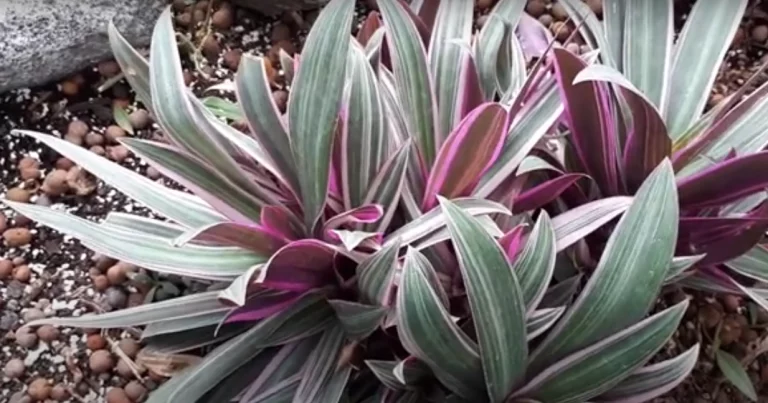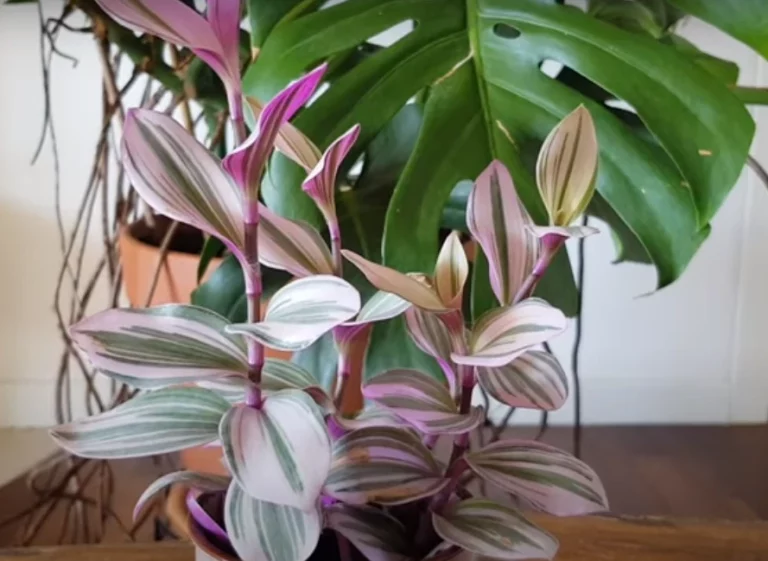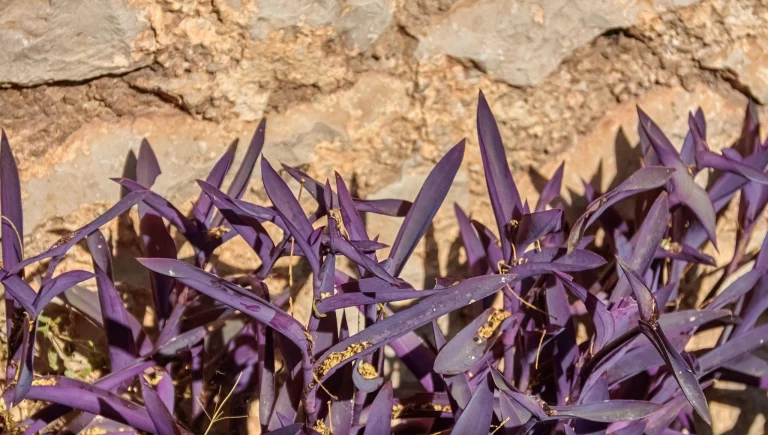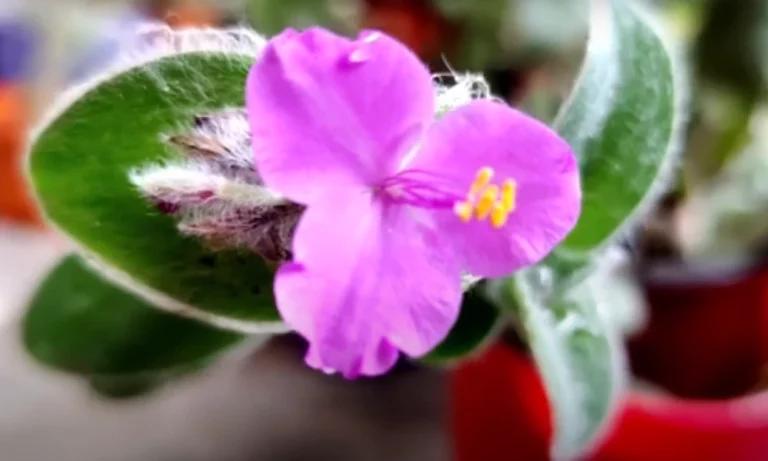Tradescantia Zebrina Growth and Care Ultimate Guide
If you’re looking to add a super easy and stylish houseplant to your indoor jungle, look no further than Tradescantia Zebrina. This trailing beauty is sure to catch your eye with its striking striped foliage in shades of deep purple, green and silvery-white.
Commonly called wandering dude or inch plant, the Tradescantia Zebrina is native to the tropics of Central America and Mexico. It’s a member of the spiderwort family and has long been popular as an ornamental houseplant. Back in the day it was known as zebrina pendula, but zebrina has stuck around as the most widely used common name. This variegated foliage plant is renowned for being an unfussy house guest that adds major visual interest without demanding much from its caretaker.
Tradescantia zebrina’s foliage boasts succulent, trailing stems lined with stunning ovate leaves. Each leaf has a dark green upper side and a deep magenta underside, marked dramatically with two bold silvery-white stripes running parallel down the midrib. It’s like each leaf got painted with natural glitter! When given sufficient light, the zebrina’s colors dazzle and pop even more. Its lush cascading stems can grow up to 3 feet long, so this little charmer makes an awesome tabletop or hanging plant.
Aside from its brilliant leaves, Tradescantia zebrina also produce small inconspicuous flowers sporadically. But let’s be real, we love this plant for its beguiling foliage. It’s ideal for beginners since it adapts readily to various light and humidity levels. While it thrives on bright light, it’s also quite tolerant of lower light. Just be prepared for its colors to fade without sufficient sunshine.
Want to invite this sparkling beauty into your plant collection? Read on to learn all about how to care for the spectacular Tradescantia zebrina!
Tradescantia Zebrina Botanical Information
Understanding the scientific classification and physical characteristics of any plant helps inform the best way to cultivate it, and Tradescantia Zebrina is not an exception, let’s look at some of its details.
Scientific Classification
In the plant world, scientific names are kind of a big deal. They allow us to universally identify plants across languages and regions. Here’s how the zebrina shakes out taxonomically:
Kingdom: Plantae
Class: Liliopsida
Order: Commelinales
Family: Commelinaceae
Genus: Tradescantia
Species: T. zebrina
So in plain English, the zebrina is part of the spiderwort family Commelinaceae. It’s categorized under the genus Tradescantia, which includes around 60 diverse species like the popular T. fluminensis (wandering Jew) and T. pallida (purple heart).
Common Names
Over the years, this striking plant has gathered its fair share of nicknames. Some of the most widely used monikers include:
- Wandering dude
- Inch plant
- Wandering Jew (less common nowadays)
- Striped wandering Jew
- Silver inch plant
- Zebra plant
Clearly its superbly striped leaves are the source of inspiration for several common handles!
Physical Characteristics
From its growth habit to its flowers and foliage, the tradescantia zebrina has some very distinct physical features:
Growth Habit
The zebrina is a tender, herbaceous perennial in the spiderwort family. It displays a trailing growth habit and propagates readily by cuttings. Given ideal conditions, it can achieve lengths of 1-3 feet as a hanging basket or trailing from a shelf. Outdoors it grows as a creeping ground cover.
Foliage
The spectacular leaves are the star of the show! Zebrina foliage is:
- Ovate or lanceolate in shape
- Succulent – stores water in fleshy leaves
- Variegated – purple above with silvery stripes
- Pubescent – covered in small hairs, giving a velvety or fuzzy texture
Stems
The flexible stems are:
- Herbaceous – soft, green, fleshy
- Cane-like and easy to bend
- Prone to breakage at the nodes
- Trailing stems can reach up to 3 feet long
- Hollow inside
Flowers
The zebrina may produce small 1 inch flowers sporadically. They are:
- White to purple in color
- Tubular 3-petaled blossoms
- Grow from leaf axils on upright stem tips
- Inconspicuous – foliage steals the show!
Roots
The roots are:
- Fibrous
- Shallow – don’t like being too rootbound
- Prone to rot if overwatered
So in summary, the tradescantia zebrina is one flashy foliage houseplant! Now that we’ve explored its botany and traits, we can use this info to provide tailored care. Onward to demystifying cultivation for this eye-catching wandering dude!
Here is a key takeaway table summarizing the main lessons from the article:
| Topic | Key Takeaways |
|---|---|
| Light Requirements | – Bright, indirect light ideal – Direct sun can scorch leaves – Supplement with grow lights in winter |
| Watering Needs | – Allow soil to dry out between waterings – Water thoroughly until it drains from holes – Avoid sitting in water |
| Humidity Preferences | – Appreciates 40-60% humidity – Mist leaves, use humidifier to increase moisture |
| Temperature Range | – Average room temp 65-80°F – No lower than 50°F at night |
| Fertilizer | – Liquid fertilizer monthly in spring/summer – Dilute to half strength |
| Pruning | – Pinch back long vines for bushiness – Shape and trim leggy stems as needed |
| Propagation | – Easy by stem tip or node cuttings – Root cuttings in water or moist soil |
| Potting Tips | – Repot in spring before growth – Rich, well-draining mix – Terracotta pots aid drainage |
| Problems | – Leaf spot, root rot from excess moisture – Mealybugs, spider mites common pests |
Zebrina Growth and Care
We’ve covered the basics and botany of this sensational spiderwort. Now let’s explore how to provide optimal growth conditions and care for the tradescantia zebrina. By understanding what makes this plant tick, you can give it the environment it craves and enjoy it for years to come!
Ideal Growing Conditions

As a tropical forest dweller, zebrina prefers warm, humid environments with dappled sunlight. Recreating these conditions indoors will yield a happy, healthy plant. Here are its ideal growth factors:
Light
Bright, filtered light is best! The zebrina thrives with:
- Indirect sunlight – east or west windows are perfect
- Bright shade – a few feet from a southern window
- No direct sun – can scorch leaves
- 12-14 hours daily – supplement with grow lights in winter
Without enough light, you’ll notice:
- Leggy, weak growth
- Pale color lacking stripes
- Smaller leaves spaced far apart
- Stem drop off
Temperature
- Average room temp is great – 65-80°F
- Above 50°F at night
- Avoid cold drafts and conditions below 55°F
- Can tolerate slightly warmer temps but prolonged heat stresses it
If your zebrina is cold, growth will slow and leaves may drop. Hot rooms can cause leaf scorch.
Humidity
As a tropical plant, higher humidity is appreciated! Shoot for 40-60% if possible. Signs your zebrina needs more moisture in the air:
- Crispy, curled leaf edges
- Dull, faded leaf color
- Brown tips or spotting
You can increase humidity by:
- Using a humidifier
- Placing pebbles in trays of water near the plant
- Grouping plants together
- Mist leaves frequently by hand
Air Circulation
- Prefers gently moving air – use a fan to avoid dust buildup
- Stagnant air encourages pests and diseases
- Avoid cold/hot drafts from vents, windows, and doors
Choosing the Right Potting Mix
Picking the proper soil is key to prevent overwatering issues like root rot. Use a:
- Fast draining mix – add perlite or bark chips to aid drainage
- Soilless potting mix – peat/sphagnum moss, perlite, vermiculite
- Avoid pure peat – retains too much moisture
- Add compost for nutrients but ensure it drains well
Terracotta pots are an excellent choice as they naturally draw out excess moisture from the soil.
Tradescantia Zebrina Watering Techniques
Proper watering practices prevent almost all tradescantia zebrina issues. Keep these tips in mind:
- Allow top 1-2 inches of soil to dry out before watering
- Check by sticking a finger in the pot – don’t rely on the top feeling dry
- Water thoroughly until it drains from holes. Discard excess water in tray.
- Avoid sitting in water – only keep the bottom 1/4 of pot in water tray
- Let soil approach dryness between waterings – 1-2 weeks in winter
- Don’t allow pots to fully dry out
- Water more frequently in hot/dry periods
- Reduce watering in winter when growth slows
- Use room temperature water – cold water shocks roots
- Be mindful of pot material – terra cotta drys faster than plastic
Adjust your schedule based on your specific conditions, pot size, plant size, etc. In general, thorough but infrequent watering is best!
Fertilizer Tips
Feeding is not essential but can promote lush growth. Use a:
- Balanced, water-soluble houseplant fertilizer
- Half strength dilution to avoid burn
- Monthly during spring and summer when actively growing
- None in fall and winter during dormancy
If your tradescantia zebrina has pale leaves with green veins, it may need iron and manganese. Seek plant-safe supplements to provide these micronutrients.
Optimal Potting
Repot young tradescantia zebrina as the roots fill out the container. Mature plants can be kept rootbound.
- Repot in spring before growth resumes
- Increase pot 1-2 inches larger than current size
- Divide congested roots – zebrinas tend to grow in clumps
- Discard old soil to prevent salt buildup
- Gently loosen root ball when transplanting to encourage growth
And there you have the complete guide to ideal growing conditions and care for the tradescantia zebrina! Follow these tips to keep your zebrina healthy and looking sensational. Next we’ll explore how to diagnose and treat problems if (okay, when!) they arise with this dramatic houseplant.
Caring for Tradescantia Zebrina
We’ve gone over ideal growing conditions for the tradescantia zebrina. Now let’s talk about how to care for it long-term and treat any issues that pop up. While zebrinas are pretty forgiving plants, they can develop problems just like any other houseplant. Being able to properly diagnose and address concerns is a key part of caring for your zebrina.
Dealing With Pests
Thankfully tradescantia zebrina aren’t prone to many major pest infestations. But here are the most common bugs you may encounter and how to tackle them:
Mealybugs
These are probably the #1 pest for tradescantia zebrina. Mealybugs look like tiny white cottony blobs on stems and leaves. They extract juices from the plant and excrete sticky honeydew. Wipe plants with alcohol to kill mealies on contact. Insecticidal soap or neem oil also smothers them. Isolate badly infested plants.
Spider Mites
Too little humidity can attract tiny red or black spider mites. Their webbing and stippling damage is a dead giveaway. Blast plants with water and wipe leaves. Apply insecticidal soap weekly until gone.
Aphids
Green, black or peach aphids cluster on new growth and distort leaves. Knock off visible insects with a jet of water. Follow up with neem oil or insecticidal soap to suffocate them. Sticky traps help control aphids.
Be sure to isolate infested plants and treat promptly before pests spread. Remove badly damaged leaves/stems.
Preventing Diseases
Tradescanti Zebrinas are generally healthy but occasionally contract fungal or bacterial diseases in the wrong conditions:
Root Rot
The #1 disease issue is overwatering. Waterlogged soil leads to root rot and eventual wilt. Promote drainage when watering and repot in fresh mix. Discard rotten roots and sterilize pots with a bleach solution before replanting. Let soil dry out well between waterings.
Leaf Spot
Bacterial or fungal leaf spot starts as brown spots with yellow halos. Prune infected leaves and avoid overhead watering. Improve airflow. Spray neem oil on leaf spots. Disinfect tools after pruning diseased parts.
Powdery Mildew
This white powdery fungal disease thrives in cool, damp conditions with poor air circulation. Improve airflow and reduce watering. Spray plants with neem oil which smothers powdery mildew. Milk sprays also help control outbreaks.
Grooming and Pruning
Proper pruning keeps your zebrina full and compact. Do it anytime!
- Pinch back long vines to promote bushiness
- Snip leggy stems to rejuvenate growth
- Remove damaged leaves and stems to improve appearance
- Shape as needed – zebrinas rebound fast!
- Control size by trimming long hanging strands
- propagate easily from cuttings – no waste!
Don’t be shy about giving your zebrina a haircut. It will respond beautifully!
Repotting Guidance
Repot young zebrinas annually as their root systems expand. Mature plants can be kept rootbound:
- Shift to a larger pot each spring before growth resumes
- Divide congested roots and dense growth
- Discard old potting mix to refresh the soil
- Gently loosen the root ball to encourage growth
- Choose a pot 1-2 inches larger than the current container
Repotting gives you a chance to examine the roots and refresh the soil. Handle the zebrina gently when transplanting to avoid damage. And there you have it – everything you need to know about caring for the spectacular yet easygoing tradescantia zebrina! Let’s recap the key points:
- Provide bright indirect light and average room temperatures
- Allow soil to dry out between waterings and supply humidity
- Fertilize monthly in spring and summer
- Watch for mealybugs, mites and other pests
- Prune back long stems anytime to promote bushiness
- Repot young plants each spring before growth resumes
Follow these care tips and you’ll have a sensational Tradescantia zebrina for years to come.
Uses
So far we’ve covered how to grow and care for the tradescantia zebrina and keep it looking fabulous. Now let’s explore some of the unique ways this gorgeous spiderwort can be used around your home and garden.
Tradescantia zebrina’s versatility, vigor, and sparkling foliage make it the perfect plant for various applications beyond an attractive houseplant. Let’s look at some of its best uses!
Ornamental Beauty
With its cascading purple stems lined with striking striped leaves, it’s easy to see why the Tradescantia zebrina is used primarily for ornamental purposes. Here are some ways to highlight its decorative flair:
- Cascading from a hanging basket to showcase its long trailing stems
- Planted in a mixed container garden to provide color and texture contrast – try combining with lime green plants like golden pothos for maximum pop!
- Positioned on a bookshelf so its strands can dangle down attractively
- As a tabletop plant with its vines spilling over the edges of the pot
- In an indoor terrarium or enclosed container – it thrives in humid conditions
- Used as a temporary ground cover or edging plant outdoors
- Allowed to trail down a wall indoors from a high shelf
- Planted as an annual bedding plant in flower beds and borders
Tradescantia zebrina versatility and vivid colors make it the perfect choice where a pop of excitement is needed!
Medicinal and Therapeutic Uses
In addition to visual appeal, tradescantia zebrina has some beneficial therapeutic properties. Traditionally it has been used:
- To treat skin conditions like eczema when applied topically
- To disinfect wounds and aid healing
- As an anti-inflammatory
- To reduce swelling
- To lower blood pressure when taken orally in small amounts
Modern research has shown extracts from tradescantia zebrina have antimicrobial and antioxidant abilities. But ingesting the plant can cause side effects, so consult your doctor before using it medicinally.
Practical Applications
Aside from ornamental and medicinal uses, tradescantia zebrina has some practical applications around the home:
- Its quick growth makes it great for filtering indoor air pollutants
- The leaves can be boiled to make a natural dye ranging from magenta to forest green depending on the pH
- It’s an easy way to add living decor on desks, credenzas, tabletops, etc.
- Due to quick growth, it’s perfect for beginner gardeners wanting to hone their skills
- Trailing over the edges, it makes an excellent dish garden plant
- Works well for temporary ground cover indoors and out
- Helps fill space quickly as other plants mature in a new garden
- Provides a pop of color in floral arrangements and bouquets
- Trailing strands can soften the edges of shelves and décor
No matter how you choose to utilize it, tradescantia zebrina is a versatile plant that earns its place through beauty and adaptability!
So there you have it – just a few examples of how this sensational spiderwort can spruce up your indoor jungle and beyond. With vivid colors and an easygoing nature, it’s sure to be a standout wherever you use it. Time to put down some roots and let those Tradescantia zebrina vines shine!
FAQs (Frequently Asked Questions)
By now you should have a solid understanding of how to grow and care for the striking tradescantia zebrina. But it never hurts to address some commonly asked questions that pop up along the journey with this sensational spiderwort! Let’s tackle the top FAQs about Tradescantia zebrina care.
Why are my Tradescantia zebrina leaves turning yellow or brown?
Leaf discoloration is typically tied to improper watering. If the lower leaves are yellowing, let the soil dry out more between waterings. If leaf tips are browning, increase watering frequency. Consistently soggy or dry soil will cause leaves to yellow and crisp up.
Make sure it’s not sitting in water and has enough drainage. Overwatering is the #1 cause of yellow leaves on zebrinas.
Why did all the purple stripes disappear from my Tradescantia zebrina?
When zebrina leaves turn solid green, it’s a sign the plant is not getting sufficient light. Place it in a brighter location out of direct sun. Supplement with a grow light if needed. The vibrant variegation requires adequate sunlight to maintain.
How can I get my leggy Tradescantia zebrina to fill out more?
Leggy growth happens when light is insufficient. Improve light exposure and prune back extra long strands near the base to encourage branching. Pinching out stem tips prompts bushier growth. Fertilize regularly to invigorate it.
What are those tiny bugs on my Tradescantia zebrina’s leaves?
Small white “cottony” blobs are likely mealybugs. Spider mites also commonly attack. Isolate and treat with insecticidal soap or neem oil. Wipe leaves to crush adults. Ensure good airflow around plants.
Why is my Tradescantia zebrina getting brown spots on the leaves?
Leaf spot is a fungal disease often tied to excess moisture. Improve drainage and water only when soil is partly dry. Remove damaged leaves and avoid wetting foliage when watering. Apply neem oil to deter fungal infections.
How often should I fertilize my zebrina?
Fertilize monthly in the spring and summer with a diluted liquid fertilizer. Discontinue feeding over winter when growth slows. If leaves are smaller and paler, increase fertilizer strength. But be conservative to avoid burn!
What is the best way to propagate Tradescantia zebrina cuttings?
Put Tradescantia Zebrina root rapidly in water or moist potting mix. Take 3-6 inch tip cuttings. Remove lower leaves and place in water/soil. Keep humid. Roots emerge in 1-3 weeks. Plant in soil once rooted. Pinch tips for bushy growth!
Is the Tradescaantia Zebrina toxic?
Yes, Tradescantia Zebrinas are toxic to humans, dogs, and cats if ingested. They contain calcium oxalates that can cause mouth irritation, vomiting, and other issues if swallowed. Keep away from pets and children. Wear gloves when handling.
Conclusion
Tradescantia zebrina is truly the full package – stylish looks, easy care, and versatile uses. With its dazzling striped foliage that brings the jungle vibes indoors, it’s a fantastic choice for beginners and experts alike. By giving it bright indirect light and allowing the soil to dry between waterings, the wandering dude will thrive for years. Let those trailing vines bring some beauty and intrigue to your indoor oasis. Growing the iconic zebrina is a breeze, so it’s time to add this sensational spiderwort to your plant family!
You might also be interested in our:




